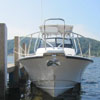|
1973 MONTAUK
|
| AJR |
Posted on 05/04/08 - 5:10 AM
|
Member
Personal Page
Posts: 26
Comments:
0
Joined: 11/12/07
|
Just when I thought I was nearing the end on "refurbing" the hull of my 1973 Montauk I may have run into another problem. The metal tube in the tunnel from the center console to the aft bilge is corroded and is "through" in several areas. Will this allow water into the foam core, or is this something you live with in a 35 plus year old boat?
Another oppurtunity I'm faced with is that when I got the boat all the wiring was in a box! I need to find a wireing diagram for a (I think 1991) 90 HP Evenrude. I don't know how wire the ignition switch and other things that are in the engine wireing harness. Any ideas where to look?
THANX
Edited by Joe Kriz on 05/04/08 - 10:45 AM |
| |
|
|
| Joe Kriz |
Posted on 05/04/08 - 10:50 AM
|

Site Owner
Personal Page
Personal Album
Photo Albums
Project Albums
Posts: 11447
Comments:
452
Joined: 03/18/05
|
I don't think there is much you can do about the inside of the rigging tunnel tube.
How can you even see in there to see any holes?
The engine wiring harness is fairly straight forward.
A good place to start is to look at this article which shows the pin outs for the connections.
http://www.whalercentral.com/readarti...rowstart=1
|
| |
|
|
| Phil T |
Posted on 05/04/08 - 12:03 PM
|

Administrator
Personal Page
Personal Album
Project Albums
Posts: 7043
Comments:
6
Joined: 03/26/05
|
Are you sure it is corroded? It may be that what you are seeing is the bare fiberglass from missing gel coat. I have seen some tunnels where they missed a spot or two. How are you seeing the tube is corroded?
If it is corroded, one idea is to rig the tunnel with smooth walled plastic hose and seal the ends. All the cables and wire would run inside of the new hose. This would "line" the tunnel and protect the foam.
To do this, you would need to de rig the boat and remove the console. Not complicated but a bit time consuming.
1992 Outrage 17 I
2019 E-TEC 90, Viper 17 2+
2018 Load Rite Elite 18280096VT |
| |
|
|
| AJR |
Posted on 05/04/08 - 12:38 PM
|
Member
Personal Page
Posts: 26
Comments:
0
Joined: 11/12/07
|
The wiring diagrams are just what I need THANX
I have the console removed from the boat and with a flashlight you can look partway down the tunnel. About 6-8 inches back in the tunnel (on the fwd part of the tunnel) it sure looks like it's corroded through. I've probed with a long screw driver and sure seems corroded thru. anyone ever run a large hose thru the tunnel? Is the tunnel surrounded by foam or fiberglass. I hate to reenvent the wheel if someone has already gone thru the process...
THANX
|
| |
|
|
| Jeff |
Posted on 05/04/08 - 6:51 PM
|

Member
Posts: 1987
Comments:
34
Joined: 04/02/05
|
I always thought the rigging tunnel was a plastic or fiberglass tube because fiberglass and resin will not bond to metals for any period for time.
1993 23' Walkaround Whaler Drive |
| |
|
|
| DelawareDan |
Posted on 05/05/08 - 6:35 AM
|

Member
Personal Page
Posts: 328
Comments:
2
Joined: 05/24/07
|
silly idea: One could make up a "mop" of cotton cloth that fits tightly in the tunnel which could be pulled through, forward and back, with ropes on both sides. This could be used to clean the tunnel. Maybe some kind of wire brush could also be used, like they use to clean chimneys (those flexible fiberglass pole segments might also be useful).
Then with a new mop, one could coat the inside with several coats of West System epoxy. Just a thought.
|
| |
|
|
| AJR |
Posted on 05/05/08 - 4:25 PM
|
Member
Personal Page
Posts: 26
Comments:
0
Joined: 11/12/07
|
Today I spent some additional time working in the tunnel---- really exciting, standing on your head with a flashlight trying to figure out whats going on ---- The tunnel is definately made of some type metal, it's non magnetic, solf, plyable and has almost a lead type consistency. Under the metal is fiberglass, or as best as I can tell, it's a hard material that acts like fiberglass when you dig into it with a screwdriver.
I cleaned as best I could and "smeared 3M 5200 over everything I could get to... including putting "globs" on a stick w/ a swab and smearing the bottom of the tunnel. If it is fiberglass under the tunnel, it should be safe...
I could have gone the route of putting in a large rubber hose and sealing both ends, BUT---- I'm not too sure how well that would work either If the boat sinks in another 5-10 years then I guess I'll know I made the wrong decission. !!!!!!!
AJR
|
| |
|
|
| Derwd24 |
Posted on 05/05/08 - 4:34 PM
|

Member
Posts: 1607
Comments:
9
Joined: 05/09/07
|
I wonder if what you had in there wasn't someone else's past attempt at a fix using a metal chase?
|
| |
|
|
| Blue_Northern |
Posted on 05/06/08 - 9:10 AM
|

Member
Personal Page
Project Albums
Posts: 532
Comments:
5
Joined: 09/04/07
|
I am with Jeff on this one. I have never seen a tube made of any kind of metal. I have a 91 Montauk and 73 Outrage sitting in the garage right now and both appear to be PVC of glass. I have the Outrage stripped and felt way up in the tunnel no metal.
Rob
1973 Outrage/Lo-Pro Conversion |
| |
|
|
| Tom W Clark |
Posted on 11/12/08 - 7:46 AM
|

Member
Personal Page
Posts: 4280
Comments:
7
Joined: 09/30/05
|
All 16'-7" Whaler hulls built from 1961 to the early 1990s used a piece of aluminum pipe to form the tunnel. The aluminum pipe was placed between the molded tunnel ends of the mold before lay up and then the entire mold including the aluminum pipe was covered with fiberglass.
It is very common for this aluminum pipe to have corroded over the years especially on boats used in salt water. Because the entire aluminum pipe is covered in fiberglass, it should not pose a problem in terms of water intrusion.
Edited by Tom W Clark on 11/12/08 - 7:47 AM |
| |
|



